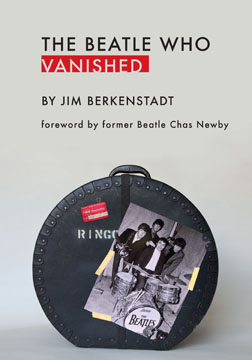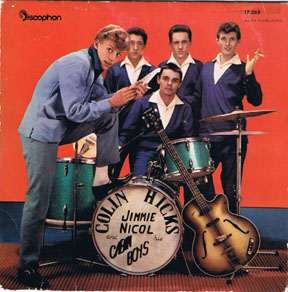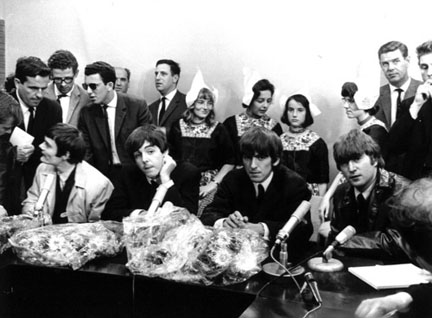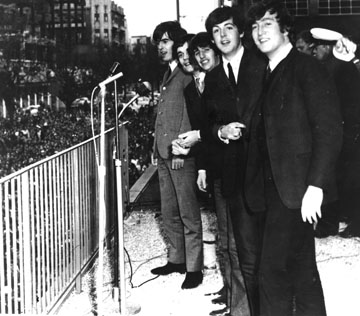Whatever happened to Jimmie Nicol? Exclusive interview with author of new book, ‘The Beatle Who Vanished’
By Marshall Terrill
Posted by Daytrippin'
February 24, 2013
Jimmie Nicol played with the world’s most famous rock group for 13 days…and then years later he walked out of his London flat and disappeared without a trace. In his new book, “The Beatle Who Vanished”, author Jim Berkenstadt uncovers the twisting trail of intrigue that has followed Jimmie Nicol since his disappearance in the late sixties.
“The Beatle Who Vanished” is the first account of Jimmie Nicol, an unknown drummer whose journey from humble beginnings to improbable climb – rescuing The Beatles’ first world tour from disaster by stepping in for an ailing Ringo Starr – was only part of his legend. Though his 13 days of fame made headlines, the true mystery of Nicol’s account is riddled with blacklisting, betrayal, drug abuse, bankruptcy and an eventual disappearance that leads many to question whether he is dead or alive.
Berkenstadt, the author of several Beatles books, spent six years of his life gum-shoeing the life of Nicol. In this exclusive interview with Daytrippin’, Berkenstadt discusses why the Beatles selected Nicol, his unforgettable 13-day tenure with the Fab Four, and how his 15 minutes of fame turned into nearly a five-decade hangover.
Q: As you so aptly state in the opening of the book, Jimmie Nicol was a classy footnote in Beatles history. So what made you decide to dedicate six years of research and writing to this project?
JB: “The Beatle Who Vanished” really started out as a challenge to see if I could find enough information to write an article about Jimmie Nicol’s life. He only ever merits one sentence in Beatles history books and no mention in British music histories. I got lucky early on finding out the general chronology of his career by locating bands he had played in and then finding members of those bands to talk to me about their lives with Jimmie. I found that almost universally his friends loved him very much and found him to be generous and highly talented. They all seemed to be rooting for him to succeed.
After a while, I was being connected to various band members from Colin Hicks & His Cabin Boys to Vince Eager & the Quiet Three, the Shubdubs and Spotnicks. This led to my compiling Nicol’s amazing discography and helped piece together the chronology of his career. The recordings I found all over the world, helped me to learn about Nicol’s amazing and creative gift as a drummer, composer, arranger and producer.
The years of writing and research were an amazing journey and challenge. Nicol was an enigmatic character. He always seemed to erase his trail when he moved on, rather than preserve it. The best way to describe my years of research is like a treasure hunt to find thousands of pieces to a giant puzzle. Then after finding all the pieces, one has to use interviews, photos, articles, video, recordings and memorabilia (i.e. posters) to fit the pieces together to create the portrait of Jimmie Nicol that readers will see in the book.
Q: You’ve been a part of the Beatles world for close to 25 years, including working as a consultant on the reissue of “All Things Must Pass” and the Traveling Wilburys box set. Not to mention your other books (“Black Market Beatles: The Story Behind The Lost Recordings” and “The Beatles Digest”) on the Fab Four. How did this help in terms of locating sources for your research?
JB: The two projects you mentioned, along with some of my work for Apple (The Beatles “Help!” DVD and the Cirque Du Soleil “Love” show) involved treasure hunts and connecting with the right people who were eyewitnesses to history. As an attorney, I became adept at research and finding almost anything on the Internet. This would include locating people who are hard to find, long lost news articles in foreign languages and lost audio and video.
Q: Like most people, I have never given much thought to Jimmie Nicol. Were you surprised by the fact that he was such an accomplished drummer before he was asked by the Beatles to fill in for Ringo Starr?
Q: Like most people, I have never given much thought to Jimmie Nicol. Were you surprised by the fact that he was such an accomplished drummer before he was asked by the Beatles to fill in for Ringo Starr?

JB: I did not know what to expect of Jimmie Nicol’s drumming at first. It took about a year to locate some early 1950s live video performances (which I will put up on my web site at www.thebeatlewhovanished.com) and listening to 45s and LPs that I collected from all of the bands he recorded with before and after his stint with The Beatles. Once I heard the music he had played on, I was blown away by his ability to play not only great rock and roll, but Ska, Big Band, Jazz, R&B and really anything. As the readers will discover, not only was Jimmie a great rock drummer who could step in at the last minute for Ringo, but through a stroke of fate, he already knew the parts to The Beatles current concert set list when they chose him.
Q: How would you compare Nicols’ style of drumming to Ringo Starr’s?
JB: It is interesting to use film clips of both Ringo and Jimmie playing drums with The Beatles, to compare and contrast. The Beatles were musically a very tight unit. They breathed, moved and played together as one. Imagine how difficult it must have been for them to launch a world tour with a brand new person to drive their rhythm? Nicol came through for them based upon his experience.
From a technique standpoint, both Nicol and Starr employed the matched-grip style of holding the sticks. This was still a new approach to drum technique in 1964. The matched-grip approach positions the weight of the arms over the stick, allowing the weight to assist in producing a bigger sound. Briefly, Ringo’s style is defined by his staying low to the drums and cymbals for the most part, using his strong/powerful wrists to get a beat that is clear, communicative and which helps define and serve key sections of the song. In contrast, Nicol’s style is more staccato than Starr’s. Nicol employs more of a whipping arm motion from a higher plane down into the drums which produces a brighter tone (Nicol also sets his stool higher than Starr for this purpose). His performances with The Beatles also highlight more of his R&B and Big Band influences in the way he breaks away from the beat and plays strong fills to set up changes in the tune.
Both styles work well to hold The Beatles together, yet of course; Ringo had recorded the songs in his style, which would be more familiar to fans. However, what fans could actually hear The Beatles at these concerts in 1964?!
Q: You cast a very large net when it came to researching Jimmie Nicols’ life – including trips to England, Holland, and Mexico. I imagine it was a surprise that this book took you around the world?
JB: Almost everything I came to learn about Jimmie Nicol’s life was a surprise. He was the definition of an independent spirit. He often chose the unexpected path. No one could tell him what to do or how to think. Each time he vanished in his career, it would take me awhile to locate where in the world he would show up next! He usually never said goodbye… just walked out the door… to another spot on the globe. Very mysterious. I tried to retrace his footsteps by traveling to England, Sydney, Adelaide and Melbourne to get a feel for the places he had lived and worked. I call that Frequent Flier Research…

Colin Hicks and The Cabin Boys EP with Jimmie Nicol on drums; courtesy Jim Berkenstadt
Q: I was also surprised in your book by the amount of newspapers articles that existed on Nichols in addition to some of the memorabilia and photos you were able to unearth. How lucky were you in this regard?
JB: The articles were not too difficult to find. I would Google rock historians in other countries who had an interest in their country’s music history. They often had links that directed me to what I needed. Google books were very helpful in locating “Billboard” magazine issues mentioning Nicol. I collected the key British music magazines at EBay in the UK.
Beatles historian Mark Lewisohn was very generous and helpful in pointing me in certain directions and helping me find obscure facts. Kudos to Mark! Many rare photos of Nicol with his various bands such as Vince Eager, The Shubdubs and The Spotnicks were generously loaned to me by band members.
The rare handbills, programs and memorabilia were found on EBay or loaned from collectors worldwide. The Beatles era video and photos are available to watch or license at archives such as Getty. I picked up a set of Beatles autographs with Jimmie Nicol that was signed on their first plane ride for a flight attendant on BEA at Sotheby’s Auctions in 1985. Priceless…. for $200. The first night concert set list from The Beatles First World Tour, (illustrated in the book) was hand-written by Neil Aspinall. He gave it to Lennon, who gave to Nicol, who used it on his bass drum. After the show, Nicol left it. Torben, the drummer for the warm up band The Hitmakers, picked it up as a souvenir and kept it for decades.
LPs were the hardest to locate. I found a Mexican LP Nicol produced and played on in the late sixties called Nicolquinn. It is the only copy in the world I have ever seen. Out of Nicol’s 10-page discography I compiled, I think there is only one 45 record I was unable to locate; likely due to anemic sales at the time.
Q: What were some of the attributes Brian Epstein was looking for when replacing Ringo Starr for the tour, and why do you think they ultimately decided on Jimmie Nicol?
JB: This was an emotional and scary time for Epstein. He had to find a fill-in for Ringo or the entire tour would collapse into a disaster of financial ruin, lawsuits against NEMS and catastrophic bad PR for The Beatles. There were no “out” clauses for illness to postpone tours in 1964. The show must go on! Epstein needed a competent drummer who could drive The Beatles bus while they could comfortably sing and play the songs out front. But he also needed someone who was mature enough not to let the experience go to his head. Maturity, diplomacy and discretion were most needed to fill in. The person chosen would be seeing and experiencing things on tour that did not fit into the current “mop top” family-friendly image, such as sex and drugs.
There are other factors as to why and how Nicol was chosen, but I will leave those to be discovered by the readers.
Q: After the elation of The Call in which Nicol was notified that he would be touring with the Beatles, what sort of pressure do you imagine he was facing?
JB: By the time of The Call, Nicol was a pro. He had played in some of England’s best first generation rock bands, led his own big band and was one of the top 5 session drummers at the time in London. He was a confident and strong player and in the book I explain in detail how he already knew most of Ringo Starr’s drum parts. I think he became nervous once all of the fan attention and media started to surround him. He realized that this was no normal gig and no everyday band. He had the stress of driving the best rock band in the world and he wanted to do his job well.
Q: And conversely, it sounded as if Ringo Starr, though he shouldn’t have been worried, was much more upset than originally reported. What do you think he was going through?
JB: Ringo felt helpless in a hospital bed watching his buddies on TV head off on their first world tour. Keep in mind, Pete Best had been replaced by Ringo after only two years. Now Ringo was being temporarily replaced (two years after Best) by Jimmie Nicol, a well-known London drummer who was in the hottest live band in town, Georgie Fame and the Blue Flames. He was likely a little insecure and worried…

Jimmie Nicol drumming for The Beatles in Adelaide, 1964;
photo courtesy Jim Berkenstadt
photo courtesy Jim Berkenstadt
Q: The most telling quote I found in the book was when Nicol got his first taste of Beatlemania. He said: “The day before I was a Beatle, not one girl would look me over. The day after … they were dying just to get a touch of me. Strange and scary all at once. It’s hard to describe the feeling but I can tell you it can go to your head. I see why so many famous people kill themselves.” That quote is in some ways a cautionary tale…
JB: This is a cautionary tale. In the words of Grammy Producer Butch Vig (Paul McCartney, Nirvana, Green Day), “This is a fascinating and mysterious must read for hardcore Beatles fans, and anyone who wants to understand the meteoric rise to pop stardom and the subsequent crash landing.”
Q: Despite all of the mayhem, it sounds like the Beatles burned the candles at both ends during this tour and Nichol had to force himself to keep up. Amsterdam, in particular, sounded like a wild time.
JB: The whole tour was pretty wild for its time, as readers will see. Keep in mind, Nicol was a few years older than The Beatles and he had done this all before. It is hard to come off stage after a Beatles concert of wild, crazy screaming and simply go to sleep. So, a good time was had by all.
Q: Nicol also endured subtle and not so subtle slights throughout the tour, including a protest by an Australian DJ for not hiring a drummer from Down Under. This must have put a few dents in his armor?
JB: Nicol was very independent and proud. He felt he deserved more respect for his subbing and “saving” the tour from cancellation and disaster. The Beatles were very friendly and respectful. They introduced him at the shows too. But others were not so kind. Along the way, managers of other bands would volunteer their drummer or a DJ would protest the loss of jobs for their country. In addition, the posters and programs all portrayed that Ringo was behind the kit – not Jimmie. Surely this annoyed Nicol, who felt at times like he was under-appreciated. I think over the years, these and other issues revealed in the book, had an impact on his psyche.
Q: They say every picture tells a story, but that photo in your book of Jimmie Nicol sitting alone in the Sydney Airport after his tenure was over is haunting…it’s almost as if you can read his mind: “My life just peaked.”
JB: That photo is quite haunting. Nicol is deep in thought. One day you are on top of the entertainment world. The next day, you are on your way home. What does the future hold? Can it ever be as amazing as what you have just gone through? Can one ever go back to their everyday life? What does 15 minutes of fame do to someone? I will leave it to readers to see what Jimmie had to say about that amazing photo. I found it in the archives of an Australian newspaper and licensed if for the book. In my mind it had to be a full page, to convey its intensity.
Nicol performed the job admirably received a 500-pound bonus and a gold watch. I can’t help but feel that he felt hollow inside.
How he felt about The Beatles experience seemed to change over the years. I don’t want to give away the story, but it is quite interesting and mysterious.

Jimmie Nicol (left) with Paul, George and John at a press conference in Amsterdam, June 1964; photo courtesy Jim Berkenstadt
Q: Thanks to your meticulous research, the Jimmie Nichol story doesn’t end in 1964. Can you give readers a brief sketch of what he did in the sixties, seventies and eighties?
JB: The research was intense. Over 700 footnotes. Hundreds of interviews with his friends, bandmates and eyewitnesses. Before The Beatles, Nicol played rock, jazz, big band, R&B and Ska in a number of bands from the late 1950s to 1964. He then started to get involved in recording sessions and arrangements. He created a pre-Beatles band called Jimmie Nicol & the Shubdubs, which he also carried on with later. Nicol rode a roller coaster of successes with different tours, recording projects and non-musical occupations. He also had failures along the way, including band breakups, bankruptcy, divorce and more.
Q: If there is a message or subtext to “The Beatle Who Vanished,” what would you like you to convey?
JB: I think this is an interesting story on two levels. First, piecing together the career of someone who is really forgotten in history is one part detective work and one part jigsaw puzzle assembly. There were thousands of pieces to Nicol’s puzzle; especially because he had the ability to vanish and move to another country. More importantly, a portrait emerged about a very talented person who experiences a huge ride to the top of the entertainment world – at a very young age and for a very short time. I wanted to explore what those 15 minutes of fame were like and how it then affects the rest of their life. Hopefully, I have been successful in conveying Nicol’s story, which is clearly a cautionary tale.
Note: Visit the official website for “The Beatle Who Vanished” at www.thebeatlewhovanished.com where you can read a free excerpt and watch the official video promo. You can “friend” the author, Jim Berkenstadt on Facebook at http://www.facebook.com/RockAndRollDetective
****
Marshall Terrill is the author of 16 books. His next literary endeavor will be a photo/passage book with guitarist Laurence Juber called “Fifty Years on Six Strings.” It will be published in November 2013 by Dalton Watson Fine Books.

Jimmie Nicol with all four Beatles in Melbourne;
photo courtesy Jim Berkenstadt
photo courtesy Jim Berkenstadt

No hay comentarios:
Publicar un comentario